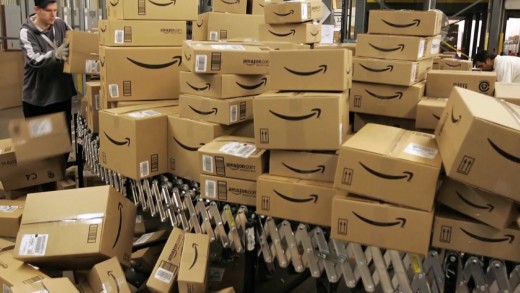Is the Amazon Business Model Environment Friendly?

Introduction
When the Amazon company first started, it was a new way to sell books. Instead of going to a book store like Barnes and Nobles, you can order the book you want online and have it delivered to your house by mail. It was heavily discounted from the retail price usually 25-40% and that savings easily offset the cost of shipping. This made a lot of sense and was a huge success. Now it has branched out into every product to sell online...The question is, is this model still the most efficient and is it good for our environment.
- Mar. 2018
Background
When it comes to the environment, we are told reducing our carbon foot print is one way to save the planet. From that perspective, every thing we do has some environmental cost associated with it. From the time a product is produced, and stored, and distributed and marketed and finally sold and delivered and eventually discarded or recycled... there is a carbon foot print for the whole life cycle.
Like it or not, Amazon has changed the way a product is distributed and made it more convenient for the consumer. A person can use their smart phone and place an order and have it arrive at their door in a matter of hours. That is amazing efficiency when you think about it. It is a testament to the vision of the technologists that developed this supply chain to make this a reality. The cost is less obvious. In order for that product to make its way to your doorstep, there is a lot going on behind the scene.
To compare this with the traditional way of purchasing a book, for example, we can see the difference and perhaps determine the cost trade off.
In the old days prior to Amazon, if I want to buy a book, one way is to go to my local mall and stop by the Barnes and Noble store, browse the shelves and perhaps ask for help from a clerk to find the book I wanted. I would browse it for a few minutes and made sure it was something I really wanted to read and purchase it and bring the book home with me. I would not make the trip just to buy the book but combine it with something else. It would not cost me extra time or energy or driving to get the book. I may have to wait a few days or till the weekend before going to the mall. I would also keep the book or give it away after I am done and rarely return it to the store because I was dissatisfied with the purchase. Some items are not returnable once used or opened. That was the old model. Alternatively, I could call the company by phone and placed an order for the book and pay for shopping to be delivered to my house. This added to the cost of the item but it saved me the trip to the mall. The delivery time is usually a few business days with conventional shipping methods.
Which is More Efficient?
In order to answer that question, you would have to examine the back office activities of each model.
The book store has a central warehouse of inventory. They would ship the books to the stores and put them on the shelves. As the books are sold, they would replenish the shelves. Depending on the popularity of the book, they may deliver a large quantity or just a few books each time. Of course this is combined with the thousand of other books being sold. Some are newly published and some are old favorites or classics. My guess is they would do this on a weekly basis. There are staff on hand to handle this process. They would have a computer system to keep track of their inventory and the sales. They would also have a phone order department to handle sells via the phone and a shipping department to handle the shipping.
In the Amazon case, they have perfected a very efficient warehouse where many products are stored in a vast facility that are automated for the most part. They have robots to retrieve the products using barcodes for identification. They then integrated this with an efficient distribution and shipping system and they provide delivery system either through FedEx or USPS using the various options that trade off cost with time of delivery. They provide an online ordering and tracking system that is superior to all others. This is the technology infrastructure that Bezos and his team invested in and built over the last 25 years.
In the case of books, there is no question the Amazon model is superior and it provides the flexibility and convenience to the consumer.
Once this process is expanded to cover other products, it becomes a more complex calculation. For example, when you order shoes for sale over the net, you must deal with the problem of returns. When the size of the shoe or the style or fit does not meet the customer’s expectation, how to handle a high rate of returns or exchanges and still be profitable.
What made this possible is the Amazon Prime membership which provided free shipping for a majority of its products. This is a tremenous advantage and draw for millennials. They are too busy and does not like shopping in malls. Mail order is more attactive especailly if it is free shipping and easy return policy.
What About the Environment?
What is the environmental impact of this paradigm shift? Can we make the case it is better or worst? And how does this affect the labor market? Instead of store clerks, we have created many more courriers and drivers and in the future perhaps drones flying around.
In my personal view, I think it hurts our environment just by the fact of the shipping boxes. The shear number and volume of shipping boxes that are being produced to support this model is got to be huge. These boxes and packing material like bubble wrap and styrofoam popcorn must be astonomical. Some of it cannot be recycled.
Summary
For all millennials, here is something to think about. You like the convenience of Amazon. Will you be willing to pay for it by harming the environment?
It is a dilemma.
© 2018 Jack Lee








